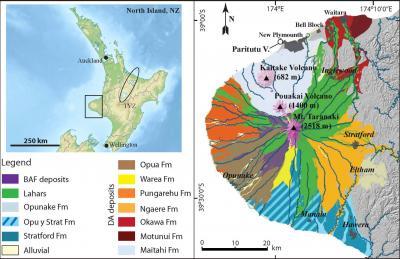Volcanic hazards aren't limited to eruptions, debris landslides can also cause a great deal of damage and loss of life.
Stratovolcanoes, with their steep, conical shapes made up of lava and unconsolidated mixed materials, can reach a critical point of instability when they overgrow their flanks. This leads to partial collapse, and the product of this slope failure is a large-scale, rapid mass movement known as a catastrophic landslide or debris avalanche.
In a matter of minutes, a debris avalanche can drastically modify the shape and nature of the surrounding landscape, covering extensive areas (in this case, up to 27 kilometers away) and changing the normal water drainage system of the region.

Location map of the Taranaki peninsula and distribution of debris avalanche deposits surrounding Taranaki volcano, New Zealand. (Credit: GSA Bulletin and Roverato et al.
About 25 thousand years ago, the biggest slope failure event known at Taranaki volcano, New Zealand, resulted in the Pungarehu debris avalanche deposit (DAD). Initial collapse of the proto-Taranaki volcano occurred near the Last Glacial Maximum, with snow and ice cover and substantial groundwater present.
The collapsing, sliding, large blocks of edifice material, known as "megaclasts," were highly fractured by the landslide generation and the depressurization event, forming pervasive jigsaw textures.
This study by scientists from Brazil, Mexico, and New Zealand provides a textural analysis of the unique features of this landslide. The authors examine grain sizes, sedimentary structures, and microscopic particle attributes and provide new insights into debris avalanche transport and internal evolution processes.
Their findings help to explain the formation of the highly irregular topography of debris avalanche deposits, with chaotically distributed (and probably temporary) zones of shear developing where softer lithologies occur in a collapsing mass, thus leading to differential velocity profiles of portions of the flowing mass in vertical and horizontal planes.
The authors write that their goal is not only to provide new insight concerning the transport and emplacement mechanisms of Pungarehu DAD, but to also improve understanding giant debris avalanche deposits worldwide.
Article: Textural features as indicators of the transport and emplacement of the >7 km3 Pungarehu debris avalanche deposit, Taranaki volcano, New Zealand.
M. Roverato et al., Instituto de Geociências IGC GSA, Universidade de São Paulo, 05508080, São Paulo, SP, Brasil. Published online 30 June 2014; http://dx.doi.org/10.1130/B30946.1.





Comments